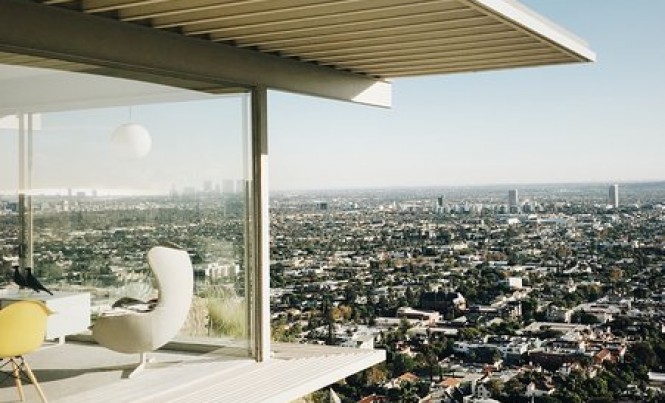
In 1969, a banner year for counterculture, the casual use of the term “hippies” in a letter penned by Dr. Philip Lovell seemed appropriate for the time. But this correspondence between Lovell, an LA-based health-food evangelist and self-proclaimed naturopath, and Richard Neutra, a pioneering modernist architect, offers fascinating insight into a relationship that would eventually reshape Southern California architecture.
“Richard, you and RMS [Rudolph M. Schindler, another modernist architect of the era] were the ‘Hippies,’ the protestors of those years in the field of architecture,” Lovell wrote to the architect of his famous home, known as the Lovell Health House, a concrete-and-steel structure built into the hills near Griffith Park in the late 1920s, when the area was still wild.
The Lovell Health House launched Neutra’s career—he described it as going from a starvation diet to a career—and helped create a template for sleek, streamlined homes. The look was liberally borrowed by the Case Study homes that would create a pattern library for midcentury modern residential design.
It also, as the name implies, was rooted in California’s longstanding role as a center for health, wellness, nutritional fads, and sunshine, as Lyra Kilston recounts in her excellent new book Sun Seekers. The in-depth look at how early 20th century wellness trends converged upon Los Angeles holds up the Lovell Health House as a reflection of both the physical and social landscape. Lovell, a nutritional advocate and newspaper columnist who embraced raw foods and sunbathing, simply wanted his new home to reflect his beliefs.
“His radical ideas about health dictated that these buildings developed the way they did,” Kilston tells Curbed. “The architect was brilliant and did plenty of incredible things, but in this case, he catered to a particular client’s interests. We have to thank LA for being the kind of place where a wacky health nut could make enough money to commission a house like this.”
One of Neutra’s apprentices named this style “raw food architecture” (critic Esther McCoy would put a sharp spin on the turn of phrase, saying that “the ‘raw-food architecture’ of the ‘20s became the caviar by mid-century”). Neutra’s design was as stripped-down and nature-oriented as a tall, tanned doctor pushing the benefits of a vegan diet.
Kilston’s book deftly connects the myriad threads between European health fads, early modernist architecture, and the synthesis of both in the high-end homes that began to stack up on Los Angeles hillsides.
In the late 19th century, Europe was a hive of research activity into the benefits of fresh air, exercise, and recouperative healing, ideas that quickly began traversing the Atlantic. There are direct connections between the sanitarium designs of Europe and New York, and what would later happen in California, according to Kilston.
In 1903, Carl Schulz established the first Naturopathic Institute in Los Angeles. It was an early milestone in the modern wellness movement, which found Southern California, and its ideal climate to be a rich breeding ground for ideas and cures.
“If you believed this stuff, it only makes sense you’d seek out a place that didn’t have winter,” she says. “If you thought crowded European cities were disease-causing, this would be the place.”
At the same time, Neutra, who had studied the nascent modernist design ideas of Bauhausmembers such as Walter Gropius, was enamored with modern architecture. Before he came to Los Angeles, he worked for the Chicago firm of Holabird and Roche, learning about new advances in steel skyscrapers and modern construction techniques. The sleek, industrial look coming to the fore in the architecture world would marry perfectly with the kind of stripped-down lifestyle being nurtured in the California sun.
As Kilston says, while the building itself is an established part of modern architecture’s family tree, the influence of the client often gets overlooked.
The creative collaboration between architect and client took advantage of all these converging trends. Lovell, who wrote a column for the Los Angeles Times Sunday magazine called “Care of the Body,” had become a local legend in a burgeoning scene filled with natural food restaurants and health spas, as he planned his new home.
Neutra’s design for the house, set into a chaparral hillside, would fuse Lovell’s ideas on health with his modernist vision: abundant windows for sunbathing, a kitchen optimized for a raw-food diet, a pool for soaking, and a yard planted with fruit-bearing avocado trees. The main interior stairway included a mounted set of headlights from a Model T Ford; a machine for healthy living.
In its bid to evoke a robust, sinewy body, the Health House pioneered new construction techniques. Neutra used a then-novel steel frame, reportedly for the first time in a residential building, and filled in the gaps with sprayed concrete, or gunite, applied by shooting it through a tube. A model of simplicity, the entire design would be included in the landmark Museum of Modern Art’s 1932 “Modern Architecture” exhibit, which would go on to define the style.
The light, airy skeleton was not only aesthetically pleasing, but lifestyle-enhancing, as laid out in correspondence from Lovell that’s quoted in Sun Seekers:
“There are plenty of opportunities throughout the house for nude sun baths privately taken for each member. Many of the windows are of the latest invention of glass, admitting ultra-violet light. The bathrooms are completely equipped with hydrotherapy equipment, including such things as sitz baths, multiple marathon showers, and the latest type of sanitary fixtures… The ventilation, sunshine, and light ideas are exceedingly modern… every inside bedroom has its accompanying sleeping porch so that sleeping can be done outdoors.”
Read today, it sounds like a celebration of the vaunted indoor-outdoor lifestyle.
As Neutra wrote, decades before the era when midcentury modern became a buzzword, “The climate of California, at least in those halcyon days before the citrus groves and bean fields were crowded out by freeways, parking lots, and subdivisions, was conducive to the germination of a fundamentally fresh form of architectural growth.”
While, like all utopian visions, the vision of a healthier, happier, hillside California would be ruined with sprawl and overdevelopment, the Health House established a template that has been repeatedly invoked, accurately or not. As Kilston writes in her book, “In the new era of antibiotics, the medicinal aura of a healthful, sun-trapping house was translated into other symbols: leisure, pleasure, wealth, the good life. The Hollywood Hills were soon dotted with flat-roofed modern homes whose walls of glass, turquoise pools, and austere patios hung over the glittering spread of the city below.”
While the Health House, which celebrates its 90th anniversary this December, has made a few cameos in popular culture—most famously stepping in as the home of Pierce Morehouse Patchett in the 1997 film L.A. Confidential, and more recently featured in Mike Mills’ Beginners—a core group of fans continues to support its future preservation. But its ongoing maintenance challenges mean the house is perhaps best known as an ideal imperfectly repeated. That home’s reality transposed against the image-saturated, myth-making city from whence it was born perhaps makes it even more quintessentially Californian.
Source: Curbed LA
Author: Patrick Sisson



